HILO — The world needs a place like Hawaii and a mountain like Mauna Kea, Mayor Harry Kim told the Office of Hawaiian Affairs trustees Thursday. ADVERTISING HILO — The world needs a place like Hawaii and a mountain like
HILO — The world needs a place like Hawaii and a mountain like Mauna Kea, Mayor Harry Kim told the Office of Hawaiian Affairs trustees Thursday.
“Do I think Mauna Kea can be done right?” said Kim, while presenting his vision for the mountain at a trustee meeting in Honolulu. “I think so.”
The mayor, who first publicly discussed the idea of a park for the mountain in broad terms after last year’s election, said he sees it as being a symbol of peace, in addition to a place to celebrate the pursuit of knowledge, Hawaiian culture and the cosmopolitan makeup of Hawaii’s people.
“I thought what the world needs now is a template, a template of hope,” Kim said. “Give us a place of hope. I think the people of Hawaii and the mountain of Mauna Kea could be that.”
For all of that to come together, he suggested there needs to be a new governing body for Hawaii’s tallest peak — sacred to Hawaiians and prized by astronomers — with OHA playing a strong role.
Most of the mountain, which is home to 13 telescopes and the site of the proposed Thirty Meter Telescope, is managed by the University of Hawaii through the Office of Mauna Kea Management under a master lease with the state.
“You were wronged,” Kim told the trustees. “The university did a poor job of management. We all need to get better. I felt Mauna Kea could be an international monument for the aboriginal people of Australia, for the indigenous people all over the world.”
Kim, who has said he supports the TMT project, which some Hawaiians strongly oppose, has said he believes astronomy fits in with that vision.
Regarding management of the mountain, UH spokesman Dan Meisenzahl said the university is proud of OMKM and efforts to improve management following a critical 1998 state audit. He quoted a 2014 audit that said: “UH has developed several management plans that provide a comprehensive framework for managing and protecting Mauna Kea while balancing the competing interests of culture, conservation, scientific research and recreation.”
“The important work of the last 17 years should not be dismissed because of mistakes made in the first 32 years,” Meisenzahl said.
Kim met with UH President David Lassner in Hilo earlier this month.
“And (Lassner) said, ‘I know we need to take a look at the whole picture and I am open to any discussion on the reorganization,” Kim told the trustees.
Hawaiians who have protested TMT came out strongly against Kim’s idea at that meeting if it still allows for building of the $1.4 billion project, which they see as desecration of sacred land.
“Mismanagement of the mountain is really the issue,” said Kahookahi Kanuha of Kailua-Kona at the meeting. “This would be a continuation of it.”
Walter Ritte of Molokai said making Mauna Kea a park would not take away the conflict.
“We’re pushed up against a cliff,” he said. “This issue should be a line in the sand.”
OHA trustee Dan Ahuna asked Kim if he was considering “taking TMT off the table.”
Kim avoided giving a direct answer, and instead went back to discussing Mauna Kea as being a symbol of peace in a world of conflict and that he doesn’t want to see more of Hawaii become like Waikiki.
OHA trustees, who as a board have taken a neutral stance on TMT, didn’t take a position on the issue but thanked Kim for speaking from the heart.
As Kim acknowledged, the county doesn’t have authority over the mountain, which is state land.
Email Tom Callis at tcallis@hawaiitribune-herald.com.



